Unlocking Your Phone's Flashlight: A Comprehensive Guide
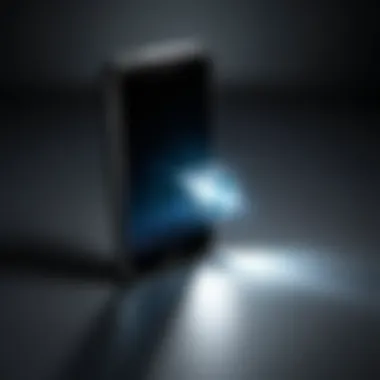

Intro
In the fast-paced world of technology, smartphones have transitioned from basic communication tools to multifunctional devices essential to our daily lives. Among the myriad of features they offer, the flashlight function is often overlooked. This unassuming utility plays an important role, offering practical solutions in various situations. Understanding its technical capabilities and practical applications can significantly enhance user experience.
Key Features
Design and Build Quality
The design of a smartphone's flashlight feature is usually integrated into the device's overall hardware. Typically, smartphones use powerful LED lights, which are energy-efficient and long-lasting. The placement of the flashlight is crucial, as it needs to be optimally positioned to provide maximum illumination without obstructing usability. Well-designed smartphones often employ sturdy materials to protect this component against daily wear.
Display and Performance
Performance is a key aspect that can vary significantly across different models. Most smartphones offer a simple interface to control the flashlight, either via a quick settings menu or through a dedicated app. High-end models tend to provide brighter illumination and better battery conservation. Features such as adjustable brightness levels can also be found, allowing users to customize the light intensity according to their needs. The efficacy of the flashlight in outdoor conditions, such as during nighttime, is heavily reliant on both the lumen count and the focus of the beam.
"The flashlight feature serves as an integral part of the smartphone ecosystem, providing practicality and convenience in various scenarios."
Practical Uses
The flashlight function can be applied in numerous situations:
- Emergency Situations: When power outages occur or when one is navigating through dark environments.
- Everyday Tasks: Finding items in dark spaces, such as under the couch or inside a bag.
- Photography: Using it as a fill light in low-light shooting conditions.
- Outdoor Activities: Aiding in camping or hiking during nighttime.
Utilizing these practical aspects can transform how one views the flashlight as simply a tool.
Troubleshooting Methods
Like any smartphone feature, the flashlight can encounter issues. Here are some common problems and solutions:
- The flashlight is not turning on:
- The flashlight is dim:
- Ensure that battery saver mode is not active.
- Restart the device.
- Check for software updates.
- Clean the LED module if it appears dirty.
- Adjust the settings to maximize brightness.
Being aware of these troubleshooting techniques can save time and frustration when the flashlight function fails.
App Integrations
Several apps can enhance the flashlight's functionality:
- Flashlight Apps: Offer features like strobe lighting or SOS signals.
- Camera Apps: Often include a flashlight option for low-light photography.
These integrations provide additional value, depending on user needs.
Epilogue
Understanding the Flashlight Feature
The flashlight feature on a mobile phone has evolved from a simple utility to a crucial tool in daily life. Its significance lies not only in the convenience it offers but also in its integration with other technologies in smartphones. It is essential to understand how this feature works and its practical applications. Knowing about the flashlight can improve user experience, particularly in various situations where access to light is vital.
As smartphones become increasingly sophisticated, the flashlight's efficiency and functionality improve as well. This section will delve into the evolution of mobile flashlights, how they operate, and the essential components that enable this functionality.
The Evolution of Mobile Flashlights
Initially, mobile phones did not incorporate a flashlight. The introduction of the LED technology marked a turning point. Over the years, advancements in smartphone design have made mobile flashlights not just brighter but more efficient. Early implementations often relied on small bulbs which were less potent and consumed battery life rapidly. With the widespread use of LED technology, flashlights became more practical. This evolution allowed smartphones to offer users a reliable source of light that is available at their fingertips.
How It Works
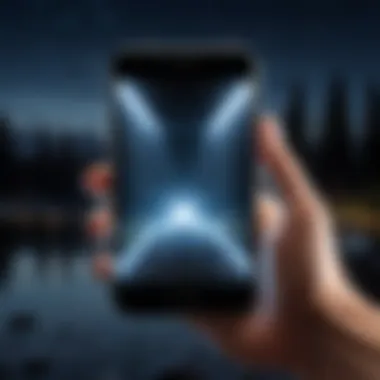

The flashlight in a mobile device operates primarily through the same principles as traditional flashlights. When activated, the LED emits light, serving various purposes from illuminating dark spaces to signaling for help. Activation typically involves a simple tap on the screen or a voice command. Phones integrate this feature seamlessly into their operating systems, making it easily accessible in emergencies or everyday situations.
Components Behind the Operation
LED technology
LEDs, or Light Emitting Diodes, have become the standard for mobile flashlights. They are energy efficient and can produce intense illumination with minimal power consumption. This aspect does not only extend battery life but also aids in providing consistent brightness. The key characteristics of LED technology include durability and immediate illumination upon activation. These attributes make it a popular choice across modern smartphones. However, the effectiveness of an LED flashlight can depend on its quality. A lower quality LED may result in poor light output.
Power management factors
Power management is crucial for ensuring that the flashlight functions effectively without draining the battery. Smartphones have built-in systems to manage power usage when the flashlight is on. This includes regulating brightness levels based on user preferences. A significant characteristic of power management systems is their ability to optimize battery life. This is important in ensuring that users can rely on flashlights during critical moments. However, poor power management can lead to performance issues and may result in unexpected shutdowns.
Integration with the camera flash
Many smartphones use the camera flash system to power the flashlight function. This integration enhances the brightness compared to standard LED flashlights. With this setup, the camera flash can activate at full capacity, providing strong light. The primary advantage of this integration is that it leverages existing technology within the device. Still, users should be aware that using the camera flash for extended durations may lead to overheating issues. This potential risk underscores the need for proper usage monitoring.
Practical Applications of the Phone Flashlight
When we discuss the utility of a smartphone's flashlight feature, it is crucial to explore its practical applications. This aspect can serve multiple purposes in daily life, showcasing versatility and adaptability. Light is a basic need for human functions and activities. The phone flashlight bridges gaps that traditional lighting cannot cover, proving its importance in both mundane and critical scenarios.
Everyday Uses
Finding objects in the dark
Finding objects in the dark is an essential function that many users might overlook. Often, we misplace keys, wallets, or remote controls. The ease of using a phone flashlight to search in low-light conditions adds immense convenience. This function allows users to quickly locate items without disturbing others with bright bulbs or overhead lights.
Features like instant accessibility — usually with just a swipe or a tap — make it a preferred method for lighting up corners or under furniture. This option reduces the time and effort spent searching for lost items and contributes significantly to user satisfaction.
Illuminating spaces during power outages
When the lights go out, the ability to use a smartphone flashlight becomes invaluable. Unlike traditional flashlights, which may require batteries and are distinct from everyday items, the flashlight on a phone is always readily available. It can illuminate whole rooms or hallways, ensuring safety during sudden blackouts.
This accessibility and immediate usage have made phone flashlights popular during emergencies. However, users should be cautious, as relying solely on a phone can lead to battery depletion. Thus, users may want to keep a secondary light source available as backup.
Emergency signaling
In urgent situations, emergency signaling can be a lifesaver. Flashlights can be used to indicate distress or request assistance. Flashes can quickly grab attention and communicate intent, whether it's flashing in Morse code or creating a strobe effect.
This functionality offers utility beyond simple illumination. It can prove advantageous in remote areas where getting help might take time. However, one must remember that the effectiveness of such signaling depends on visibility. Thus, knowing the limits of one’s phone's flashlight is crucial.
Professional Applications
Inspection tasks
Inspection tasks in various professions can benefit from the multifunctionality of phone flashlights. Electricians, plumbers, or inspectors frequently face poorly lit areas where precision is key. In such instances, a smartphone flashlight provides an immediate solution without requiring extra equipment.
This application enhances efficiency in workplace routines, allowing for clearer views in tight spaces. While not a replacement for specialized lighting tools, it gives workers a helpful option.
Construction site utility
In construction environments, proper lighting is critical for safety and efficacy. Here, the phone flashlight can serve as a supplementary device for checking tools or reviewing plans in dimly lit conditions.
Yet, it is essential to understand that while phone flashlights are practical, they cannot replace dedicated construction lights entirely. Users should approach applications cautiously to maintain safety standards on-site.
Medical field uses
In medical settings, professionals often need portable light sources for examinations. The flashlight function on smartphones can assist in checking pupil response or examining wounds. Its compact nature allows medical practitioners to carry it comfortably.

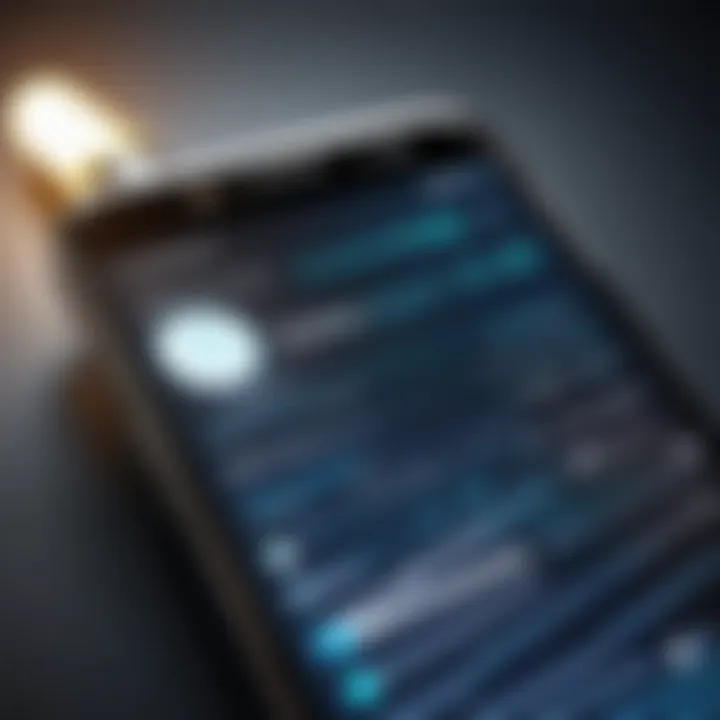
However, while convenient, the quality and spectrum of light may not match specialized medical lights through full-fledged instruments. Thus, while useful, the phone flashlight serves as an augmentation rather than a substitute.
In summary, the phone flashlight is more than just a novelty; its practical applications span everyday life, professional environments, and emergencies making it a versatile asset in any situation.
Troubleshooting Common Issues
The functionality of your phone's flashlight can vary significantly depending on myriad factors, including the device’s model and the software version in use. When users experience issues with this seemingly simple feature, it can be frustrating. Understanding common problems and their solutions can lead to quick resolutions, enhancing the standby utility of your flashlight. Moreover, troubleshooting empowers users to maintain control over their devices, ensuring reliability when least expected.
When the Flashlight Doesn't Turn On
One frequent problem is when the flashlight refuses to turn on, leading to confusion and sometimes panic. This could stem from several causes.
- Software Glitches: Sometimes, a minor software issue may cause the flashlight feature to become unresponsive. Restarting the device often resolves these simple glitches.
- Battery Conservation Settings: Most smartphones have features aimed at preserving battery life. If these settings are overly aggressive, they might disable the flashlight. Checking the power-saving options can clarify this.
- App Interference: Certain third-party apps might conflict with the native flashlight function. Disabling or uninstalling unfamiliar apps may help restore proper functionality.
- Hardware Damage: In some cases, physical issues, such as hardware damage, could be the culprit. If the flashlight remains unresponsive despite troubleshooting, consider seeking professional assistance.
Inconsistent Brightness
Another issue users frequently face is inconsistent brightness levels from the flashlight. This can be particularly annoying when precise illumination is needed. Several factors contribute to this problem:
- LED Quality: Not all flashlights are created equal. The type of LED used in the smartphone plays a significant role in the brightness consistency. Lower quality LEDs may not maintain steady outputs over time, which leads to fluctuating brightness.
- Heating Effects: As the flashlight is used, it may not only cause the device to heat up, but also potentially affect the brightness. If the unit becomes too hot, it may automatically dim to avoid further damage.
- Software Control: The operating system regulates the flashlight’s output. If the software experiences bugs or conflicts, the brightness can appear erratic. Keeping the device updated tends to mitigate such issues.
Overheating Problems
Overheating is a more concernin issue that can arise from excessive use of the flashlight feature. This problem poses risks to both the device and the user. Some considerations include:
- Physical Examines: If your smartphone heats up significantly when using the flashlight, this may indicate a deeper issue. Check if the back panel becomes hot to touch, signalling that the flashlight and possibly other functions are overworking the device.
- Extended Use Risks: While modern smartphones are designed to handle the function, continuous operation can lead to overheating. Limiting use during high-intensity tasks will extend the lifespan of the device.
Regularly monitor the heat level when using the flashlight. If it becomes excessively hot, consider turning it off temporarily to avoid damage.
Optimizing Flashlight Usage
Optimizing flashlight usage on your smartphone is a critical aspect that can greatly enhance its functionality and convenience. Understanding and adapting light settings not only improves visibility but also prolongs battery life. This section will delve into two specific elements: adjusting brightness levels and utilizing timers and automatic shutdowns. Each of these strategies brings unique benefits that cater to different user situations, emphasizing the overlooked importance of flashlight optimization.
Adjusting Brightness Levels
The brightness level of your phone's flashlight is more than just an aesthetic choice; it directly affects illumination intensity and energy consumption. Many smartphones provide options to adjust brightness, enabling users to tailor the light output to their immediate needs. Adjusting the brightness can be especially useful in various contexts, such as reading in low light, signaling in emergencies, or illuminating a workspace.
Using a dimmer setting can save battery life, which may seem trivial but is essential during extended use, such as during power outages. The durability of the bulb also benefits from lower brightness because it generates less heat. Depending on the model, some smartphones even allow quick toggling between brightness settings, making it easier to adapt to changing environments. This feature not only serves functional purposes but also enhances user experience in general.
Timers and Automatic Shutdowns
Timers and automatic shutdown features can significantly enhance the practical use of your phone's flashlight. By utilizing these settings, you can prevent battery drain caused by forgetting to turn off the light after use. Some flashlight applications incorporate built-in timers, allowing users to set specific durations for illumination. This feature is particularly beneficial in scenarios like reading at night, where you may want light just for a short period.
Automatic shutdown functionalities can further complement this by sensing inactivity after a set timeframe. Such a feature serves dual purposes: extending battery life and preventing unnecessary heat generation, which helps maintain the longevity of your device's LED. Additionally, users who are engaged in a task can implement these settings without distraction, ensuring that the flashlight turns off automatically when the user no longer needs it.
Optimizing your phone's flashlight can lead to better battery management and enhanced functionality in various real-world applications.
In summary, optimizing flashlight usage is about being aware of how you can manage brightness levels and employ timers effectively. Paying attention to these elements ensures not only the usability of the flashlight feature but also safeguards the longevity of your device and extends its overall utility.
Apps to Enhance Your Flashlight Experience
In the digital age, the role of smartphone flashlight apps extends beyond mere illumination. With innovations in technology, there are applications specially designed to maximize the functionality of built-in flashlights. These applications can modify brightness settings, add features such as strobe and SOS modes, and even integrate with external devices for enhanced utility. Understanding this aspect of smartphone use can optimize user experience, especially for tech-savvy individuals who appreciate maximizing their devices' potential.
Reviewing Popular Flashlight Apps
Several popular flashlight apps serve different user needs. For example, Flashlight by DJM offers a simple interface, allowing users to operate the flashlight with just a tap. It provides features such as adjusting brightness and using different lighting effects. Another widely recommended app is Tiny Flashlight + LED, which enables users to customize their flashlight experience. This app includes features like a strobe light, various color filters, and functionality for generating light patterns. Users can select from these apps based on their preferences, enhancing their overall flashlight experience.
Integration with Smart Home Devices
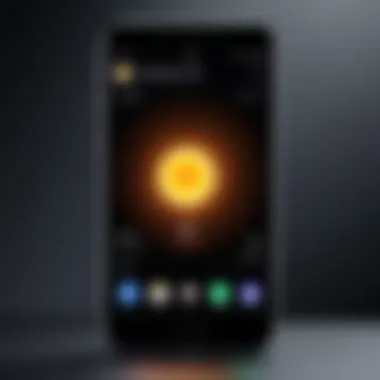
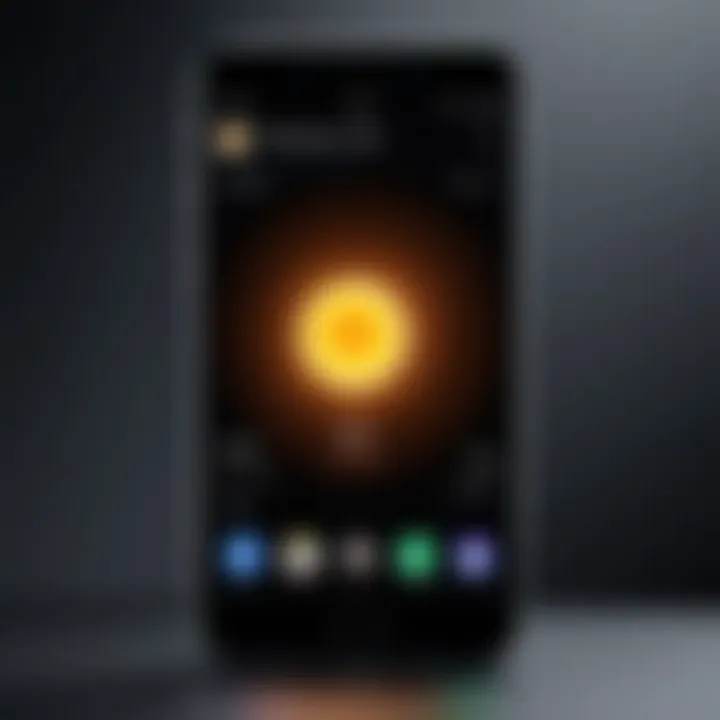
With the rise of smart home technology, integrating smartphone flashlights with these devices opens new possibilities. Users can operate their home lighting systems directly from their phones, blending traditional flashlight tasks with smart home features. For instance, users can synchronize their flashlight operation with smart bulbs or movement sensors, allowing for a seamless transition from outdoor to indoor lighting. This combination not only increases convenience but also improves safety in dimly lit areas.
"The combination of smartphone and smart home technology magnifies the utility of everyday tools, crafting a truly user-centric experience."
Advantages of app integration include the ability to automate lighting scenarios. Using apps like Google Home or Amazon Alexa, users can create routines. For example, you can program your flashlight to turn on automatically when a door is opened at night. This adds an element of security and efficiency to how we use light in our environments. Such integrations offer substantial benefits, particularly for individuals who prioritize convenience and safety in their home setups.
Security and Safety Considerations
The flashlight feature on smartphones extends beyond mere utility. It plays a vital role in ensuring personal safety and enhancing visibility in various situations. In environments where visibility is compromised, such as during power outages or nighttime activities, the flashlight can significantly improve awareness. Using the phone's flashlight permits users to navigate their surroundings with minimal risk of accidents. Additionally, it's a tool that can foster a sense of security, especially in unfamiliar areas.
Visibility and Awareness
Visibility is paramount in both everyday and emergency scenarios. The brightness levels provided by most smartphone flashlights are suitable for illuminating pathways, enabling people to see potential hazards.
- Walking Alone at Night: Many individuals feel more secure if they can illuminate their surroundings. This can deter unwanted attention or ensure awareness of any approaching vehicles.
- During Outdoor Activities: Whether hiking or camping, a phone's flashlight can be crucial for safe navigation. It allows for a clear view of trails or potential obstructions, thus preventing injuries.
- Home Use: In case of power outages, the flashlight feature can light up critical areas such as staircases and hallways, reducing the likelihood of accidents.
Overall, maintaining visibility allows individuals to make more informed decisions, hence ensuring their safety.
Potential Risks of Usage
While the flashlight feature is beneficial, its use carries some risks that should be acknowledged. Understanding these can help users navigate situations more safely:
- Battery Drain: Continuous usage of the flashlight can lead to significant battery depletion. This situation may leave users without power when needed for other critical functions, such as emergency calls.
- Overheating Risks: Extended usage may cause the device to heat up. In certain models, this can lead to thermal throttling which reduces performance or, in rare cases, hardware damage.
- Unintentional Distraction: Relying on a phone's flashlight while walking or driving can result in distraction. It may divert attention from surroundings, hence increasing the risk of accidents.
- Security Concerns: Using your phone's flashlight could inadvertently expose a person’s location. If in a precarious setting, such as an unfamiliar area, this could attract unwanted attention from others.
By recognizing these potential risks, users can take steps to use the flashlight feature more wisely, ensuring that it serves its intended purpose without compromising safety.
Comparative Analysis with Dedicated Flashlights
Understanding the comparative strengths and weaknesses of phone flashlights versus dedicated flashlights is crucial in determining which lighting solution best fits a user's needs. This analysis highlights the key distinctions in functionality, portability, and specific uses, offering readers an informed choice when relying on illumination tools. As smartphones continue to integrate multifunctional features, it’s essential to evaluate how effectively the flashlight feature operates compared to traditional flashlights.
Advantages of Phone Flashlights
Phone flashlights have several distinct advantages that can appeal to a broad range of users:
- Portability: The most notable advantage is that a smartphone is likely already in your pocket. This makes the phone flashlight readily accessible, eliminating the need to carry an extra device.
- Integrated Technology: Many smartphones today feature advanced LED technology that can produce a focused beam of light. This often results in a brightness comparable to that of small dedicated flashlights.
- Multiple Functions: Beyond simple illumination, phone flashlights often come with various settings, such as strobe or SOS modes, making them versatile for different situations.
- Battery Management: Smartphone flashlights are integrated with the phone’s battery management system. Users can monitor battery life easily, and if the phone needs charging, they can use a power bank or wall charger through common charging ports.
- App Compatibility: Some flashlight features may allow integration with apps that can enhance functionality, such as adjusting brightness levels or setting timers for usage.
Disadvantages and Limitations
While the benefits are significant, phone flashlights also have limitations that need careful consideration:
- Power Consumption: Using the flashlight can drain your smartphone’s battery quickly. In an emergency, this might limit your phone's functionality, including the ability to make calls or access critical apps.
- Heat Generation: Extended use can cause your phone to heat up. Overheating can impact the device's performance and longevity, potentially leading to issues that a dedicated flashlight wouldn’t face.
- Brightness Limitations: Although LED technology has improved, phone flashlights may not provide the same level of brightness or range as a high-quality dedicated flashlight. This can be particularly evident in outdoor or extensive lighting scenarios.
- Durability Concerns: Dedicated flashlights are often designed for rugged use and may be water-resistant or withstand drops. In contrast, the average smartphone may not have the same level of durability, making it less suitable for harsh conditions.
- Ergonomic Design: Dedicated flashlights are specifically designed for illumination tasks, often featuring designs that allow for better grip and targeted light direction. In contrast, the design of a smartphone does not prioritize flashlight functionality.
In summary, understanding the pros and cons of phone flashlights compared to dedicated devices helps users to make informed choices based on their needs and contexts.
Future of Flashlight Technology
The landscape of smartphone technology is constantly evolving. The flashlight feature, a utility many take for granted, is no exception. As we look ahead, the future of flashlight technology is becoming increasingly significant not just for functional use, but also for enhancing user experiences. This section will explore specific innovations anticipated in coming years, along with the integration of augmented reality, which could redefine how we perceive and use this simple tool.
Innovations on the Horizon
Technology is advancing rapidly, and the flashlight feature is set to benefit from various emerging trends. Here are some key innovations that may impact this functionality:
- Adaptive Brightness: Future flashlights could utilize sensors that automatically adjust brightness based on external light conditions. This means that your smartphone can offer optimal illumination without blinding you or using excessive battery life.
- Color Customization: Imagine being able to change the color of your flashlight depending on the ambiance or the application. Future models could enable such features for a more tailored user experience.
- Enhanced Battery Efficiency: Battery life is a critical consideration for portable devices. Upcoming flashlights might incorporate more energy-efficient components that extend operational time significantly.
- Smart Detection: This could involve the flashlight responding to user voice commands or facial recognition. By recognizing who is using the flashlight, the phone can adjust settings automatically.
These innovations signify a shift toward more personalized and intelligent utilities within smartphones. Such evolutions promise not only to maintain function but also to improve convenience in various contexts.
Integration with Augmented Reality
The integration of augmented reality (AR) with mobile flashlight technology presents opportunities for novel applications. Here are some potential uses:
- Enhanced Navigation: AR can overlay directions or information in a real-world context. When combined with the flashlight, users can illuminate paths while receiving navigational hints directly projected onto their environment.
- Interactive Learning: In educational settings, this technology could be used for interactive lessons. For instance, students could point their smartphones at objects and see relevant information when using the flashlight in augmented reality mode.
- Maintenance and Repairs: For professionals in fields like construction or repair, AR combined with flashlight functionality can assist in showing schematics or guidance in real-time while illuminating the work area effectively.
- Gaming Experience: The gaming industry could also leverage this integration, allowing users to engage in experiences where they physically interact with the environment through their phone's flashlight functionality.
"The integration of AR with flashlight technology could redefine interactions with our surroundings, making them more informative and intuitive."



